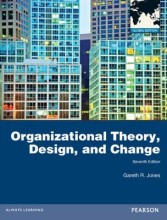Summary: Organizational Change For Pre-Msc
- This + 400k other summaries
- A unique study and practice tool
- Never study anything twice again
- Get the grades you hope for
- 100% sure, 100% understanding
Read the summary and the most important questions on Organizational Change for Pre-MSc
-
1 Chapter 1: Organizations and their changing environments
This is a preview. There are 6 more flashcards available for chapter 1
Show more cards here -
Organizations (Tony Watson, 2002):
organizations have goals which act as a glue holding together the various systems used to produce things. -
Brooks (2004) sees the environment as
a general concept which embraces the totality of external environmental forces which may influence any aspects of organizational activity’. To some extent the environment is a construction of reality. Similar organizations in the same sector while battling with the same forces may construct the significance of events quite differently. -
PEST (external) factors and organizational change:
- Political factors
- Economic factors
- Socio-cultural factors
- Technical factors
-
Organizational response to change Organizations operate in at least three types of environment, which together make up the total ‘operating environment
- Temporal environment: historical developments bringing changes over time. This is an environment that influences the organization in at least two ways:
- Through the cycles of industry-based innovation > major series of developments
- Through the cycle of the organizational itself > history built up from its founder days through periods of expansion and decline
- PEST framework (external)
- Internal environment: consists of those organizational changes that are the first-line responses to change in the external and temporal environments
-
The dynamics of any organization’s environment have also been described in terms of the degree of environmental turbulence. A firm’s performance is optimized when its aggressiveness and responsiveness match its environment (Ansoff and Mc Donell, 1990). Five levels of environmental turbulence:
Predictable Forecastable by extrapolationPredictable threats and opportunities- Partially predictable opportunities
Unpredictable suprises
-
(Ansoff and Mc Donell, 1990). Five levels of environmental turbulence: 1 predictable
stability ofmarkets ;change isslower than the organization’sability to respond; thefuture is expected to be the same as the past. -
(Ansoff and Mc Donell, 1990). Five levels of environmental turbulence: 2 Forecastable by extrapolation
complexity increases butmanagers can stillextrapolate from the past andforecast the future withconfidence . -
(Ansoff and Mc Donell, 1990). Five levels of environmental turbulence: 3 predictable threats and opportunities
complexity increases and the organization’s ability to respond becomes more problematic; however, the future can still be predicted with some degree of confidence. -
(Ansoff and Mc Donell, 1990). Five levels of environmental turbulence: 5 unpredictable suprises
turbulence increases with unexpected events and situations occurring more quickly than the organization can respond. -
2 Chapter 2 : The nature of organizational change
This is a preview. There are 13 more flashcards available for chapter 2
Show more cards here -
Grundy’s (1993) varieties of change
Smooth incremental change: evolves slowly in asystematic andpredictable way;Bumpy incremental change:characterized by periods of relative calm,punctuated byacceleration in the pace of changeTriggers : both theenvironment and andinternal initiatives such as theperiodic restructuring thatorganizations go through to improveefficiency .Associated with the means by whichorganizations achieve their goals, rather than as a change in the goals themselves.Discontinuous change: change which is marked by rapid shifts instrategy , structure, orculture , or in all three.- Triggers: response to sudden and unpredictable high levels of environmental turbulence.
- Higher grades + faster learning
- Never study anything twice
- 100% sure, 100% understanding































